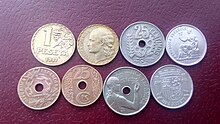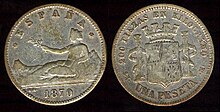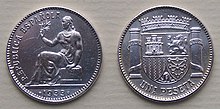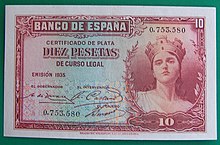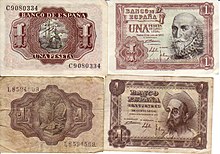Peseta
The peseta was the legal tender in Spain and its overseas territories from its approval on October 19, 1868 until June 19, 2001, when the euro was adopted as the legal tender, although it was definitively withdrawn from circulation in March 2002 after a transitory period. After the first minting of pesetas, the existing reales de vellón continued to circulate, which were equivalent to 25 ctm of peseta; even when the vellón reales disappeared, the 25 ctm coins continued to be called real and the 50 ctm two reales.
After the introduction of the euro, the peseta continued to circulate until December 31, 2001 with the legal status of a "non-decimal fraction of the euro" and then, provisionally, until February 28, 2002. On January 1, that year euro coins and banknotes had entered circulation, with which he lived for two months.
In 2020, some 1,590 million euros in pesetas were kept in private hands. Although the Bank of Spain was scheduled to stop exchanging pesetas on December 31, 2020, it extended the term until June 30, 2021 to return the 264,553 million of the old national currency, at no additional cost, for euros, at the exchange rate of €1.00 = 166.386 ESP.
History
The Dictionary of Authorities of 1737 defines the peseta as «the piece worth two silver reales of provincial currency, formed in a round figure. It is modernly introduced voice".
The first coin to be minted with the inscription pesetas was a coin minted in Barcelona for 2½ pesetas, in 1808, during Napoleonic domination. The corresponding peseta coin > it was minted in 1809, the year in which the 5 pesetas (the size and weight of the 8 reales) was also minted, which worked until the end of the Spanish War of Independence. There was also a sporadic issue of a 5 pesetas coin in the Balearic Islands in 1823.
Etymologically, peseta comes from the Catalan peseta, diminutive of peça ('piece'), so it would be equivalent to «little piece».
Later, after the coronation of Isabel II as queen of Spain, during the years 1836 and 1837, coins were minted again with the inscription 1 peseta; with them the queen paid the institutional troops who fought in the first Carlist war in favor of her cause and against that of the Carlist pretender Don Carlos María Isidro de Borbón, who were later called peseteros .
On October 19, 1868, the Minister of Finance of the provisional government of General Serrano, Laureano Figuerola, signed the decree establishing the peseta as the national monetary unit, replacing the shield as such. Its introduction was determined for political reasons, erasing the vestiges of the Bourbon monarchy (overthrown on September 30 of that year with the triumph of La Gloriosa) in the pieces in use at the same time; and economic, when the decimal metric system officially entered into force in the context of the Latin Monetary Union.
History of peseta coins
The first peseta was minted in 1869, it weighed 5 grams of silver and was equivalent to 4 reales. The coins of the first issue were:
- 1 cent, 1 g of bronze
- 2 cents, 2 g of bronze
- 5 cents, 5 g of bronze
- 10 cents, 10 g of bronze
- 20 cents, silver g 900 thousandth
- 50 cents, 2.5 g silver, 900 thousandth
- 1 peseta, 5 g of silver law 900 thousandths
- 2 pesetas, 10 g of silver law 900 thousandths
- 5 pesetas, 25 g of silver law 900 thousandths
- 100 pesetas, 32,25 g of gold law 900 thousandths.
Until the entry into force of the peseta as the only Spanish currency, there were 21 monetary units in circulation in Spain.
Until the Second Republic, the 1 peseta coins were minted in silver. The first non-precious metal peseta was manufactured in 1937. On it appeared the face of a woman, representing the Republic. These coins were known as la Rubia, a color given by the brass alloy.
In 1939, the Francisco Franco regime withdrew precious metal coins from circulation and minted peseta coins imitating the design of the Yugoslav dinar; the coins had values of 5 and 10 cents, aluminum (which were still called perra chica and perra gorda, although the figure had been changed to a horseman), 25 cts (one is), 1 pta and 5 pta (a duro); Later, one of 50 cents (1951) and another of 2.5 pta (1954) were also added, which circulated relatively little. These coins were manufactured from 1944 to 1982 and were legal tender until 1997. Around 1958, due to inflation, coins with a higher face value were put into circulation, such as 25 and 50 pesetas, and later the 100 silver pesetas of 800 thousandths from 1966.
Since the Spanish Transition, the coins had the portrait of Juan Carlos I. In 1980, commemorative coins for the 1982 Soccer World Cup were produced in 50 cents, 1, 5, 25, 50 and 100 pesetas.
Starting in 1982, the one peseta coins were manufactured in aluminum to reduce production costs, although with the same dimensions as the previous ones. In 1982 the new 100 pesetas coin was put into circulation, more compact and made of bronze-aluminum material. As novelties, new coins were also put into circulation: in 1982 the 2 pesetas coin in aluminum, in 1983 the 10 pesetas in cupronickel, in 1986 the 200 pesetas also in cupronickel, and in 1987 the 500 pesetas in bronze material -aluminum. These last two coins begin to replace the circulating banknotes of that value, which from that date begin to be withdrawn from circulation. In 1983, all fractional currency, with a value of less than one peseta, was discontinued, since they were no longer accepted in the legal course of the country's economy.
It was in 1989 that the production of aluminum pesetas with only 14 mm in diameter began, one of the smallest coins in the world. The last series of coins alternated the colors white and yellow between consecutive values; the most commonly used coins are gold (5, 25, 100 and 500 pesetas) and the less common coins are silver (1, 10, 50 and 200 pesetas). Starting in 1992, a program of thematic coins began, launching that year coins of 5, 25 and 50 pesetas commemorating the Barcelona Olympic Games and the Seville Exhibition, and the following year, the Jacobeo; Subsequently, each year coins were minted with the names and images of the autonomous communities and cities of Spain, except for Catalonia, Andalusia and Galicia, which were already represented by the coins of their events. The only community that did not appear in this series of coins was the Valencian Community. At the same time, another program minted coins of 10, 50 and 200 pesetas dedicated to historical figures from Spain. In 1994 the 2000 pesetas coin was launched, although with little circulation and reserved for collectors.
In 1997, the 1, 5, 25, 50 and 200 pesetas coins of old design were withdrawn from circulation (the designs prior to 1989, which in some cases had been in circulation since the 1940s), as well as the coins of 100 pesetas of great diameter, little known due to its scarce circulation; Until then, coins from several different series had coexisted. In its last years of existence, the peseta had so little value (coming to be equivalent to 200 pesetas to one US dollar) that the one peseta coin had practically disappeared from circulation, and the monetary unit in practice was the duro (5 pesetas). The last issue of peseta coins dates from 2001.
The pesetas continued in circulation until February 28, 2002, with the entry of the euro, after 133 years of validity.
History of peseta bills
The first peseta bills were printed on July 1, 1874. They had face values of 25, 50, 100, 500 and 1000 pesetas. Due to their high value at the time, they were only intended to be handled by banks and other financial entities. In total, barely two million of this first series were issued.
The banknotes issued in new series continued to have these same values, until 1935. Due to the devaluation of the peseta in those years, and the fear that the increase in the price of silver could cause the disappearance of the coins of 5 pesetas (silver duros) to be sold as metal, proceeded in 1935 to issue 5 and 10 pesetas bills, as "Silver Certificate", with the 5-pt silver coins being withdrawn. of circulation.
During the Spanish Civil War, the country's economy collapsed and with it its currency. Even with the devaluations, the Bank of Spain had to print banknotes of lower values, such as 50 cents, 1, 2, 5 and 10 pesetas, due to the impossibility of buying metals.
After the recovery of the Spanish economy, the country's monetary needs changed. In 1974 there were already 700 million banknotes in circulation, many of them of low denomination, and in 1978 the figure reached one billion. Despite the fact that the peseta had lost value, the highest value bill was still the 1000 pesetas and many of these bills were necessary for important payments.
For this reason, since the 1970s, smaller bills have been withdrawn to be replaced by new denominations. The issuance of the first 5,000 pesetas bill in 1976 was the first time in more than a century that a bill of more than 1,000 pesetas was put into circulation. In 1979 the penultimate series of peseta banknotes was introduced, with a different color code for each value. The same series was completed with the 2,000 pesetas (1980) and 10,000 pesetas (1985) notes. In 1982, the printing of 100 pesetas or less notes ceased, and in 1987 they stopped manufacturing 200 and 500 pesetas notes, and coins of these amounts began to circulate.
In 1992, the last banknotes in circulation were introduced (1,000, 2,000, 5,000 and 10,000 pesetas) with smaller dimensions than those of the previous series. In 1997, all the banknotes of the series prior to those of 1992 were withdrawn from circulation. The four banknotes of the 1992 series remained the only ones in force in the last years of the peseta's life, until the introduction of the euro in 2002.
The peseta in other countries
The Equatoguinean peseta was the official currency of Equatorial Guinea from 1969 to 1975. Different types of coins and bills were issued, all following the model of the pieces circulating in Spain at that time. Coins of 1, 5, 25 and 50 Equatoguinean pesetas were minted, as well as bills of 100, 500 and 1000 pesetas.
The only currency currently in force that bears the name of the peseta is the national currency of the Sahrawi Arab Democratic Republic, known as the Sahrawi peseta. This unit is equivalent to the value of the old Spanish pesetas, it is de facto linked to the single European currency with a convertibility of 166.386 Sahrawi pesetas per euro. This currency has an official character only de iure, since it does not circulate effectively among the population, since in the area occupied by Morocco the currency in use is the Moroccan dirham, while in the area controlled by the Polisario Front circulates the Algerian dinar. Even so, coins of 1, 2, 5, 25 and 50 Sahrawi pesetas continue to be issued for common use and commemorative pieces in various values, minted in fine metals.
Peru also minted silver coins with the denomination «peseta» in 1880. The coins, with values of one and five pesetas, have a female figure on their obverse and the following text: «Prosperity and power for Justice. 1880». On the reverse, around the coat of arms of Peru, it reads: "República Peruana Lima 9 tenths. Fine B.F.» followed by the value: one or five pesetas.
Etymology
There are two possible etymological origins of the name of the currency: one indicates that the word peseta comes from the Catalan word peceta ('piececita'), diminutive of peça ('piece'), a name by which it has been known since the century XV to some silver coins and later designated the real de a dos. The other, collected by the Royal Spanish Academy, points out that peseta is simply a diminutive of the word peso, a name given to the old Spanish silver coins and where the name comes from. name of the current monetary units of various American countries.
Nicknames
Colloquially, the peseta has received other names, such as pela, rubia, cala or even chufa, often used in conjunction with large quantities to indicate an excessive price. Example: «The computer has cost me 150,000 pelas».
The peseta coins and bills had their own nicknames: the 5-cent coin was called perra chica, the 10-cent coin was called perra gorda, and the 25 cents was given the denomination of real. The 5 pesetas coin was known as the duro (in Galicia, "peso"); the 100 pesetas bill simply as a billet (the last issue of 100 pesetas bills was in 1970, and in 1982 it was replaced by the 100 pesetas coin which, in turn, was usually called the 100 pesetas coin). 20 duros or libra), although due to the withdrawal of these bills, by the 1990s that term had fallen into disuse, the 500 pesetas bill, as one hundred dollars; the 1000 pesetas bill, such as talego, napo or green bille; and the one for 5,000 pesetas, like sweet potato because of its brown color, similar to that of the skin of this vegetable or, by equivalence, it was also called the one for a thousand dollars.
Derived terms
The word peseta gave rise to the term pesetero, used to designate someone who is interested in money above all else.
With the introduction of the euro, the words pesetero or pesetista were used to refer to people who have not adapted to the single currency and make their mental calculations in the old coin, characterized by its typical phrase "How much is that?" when given a price in euros. Some older people continue to calculate the value of their income and expenses in pesetas, particularly when it comes to high figures.
The term peseta is also used, agreeing it in the masculine (un peseta, el peseta) to colloquially refer to taxi drivers; use that is maintained despite the change of currency.
In Puerto Rico, the entire population of the island currently calls the 25-cent coin peseta and the 5-cent coin vellón. The term peseta is commonly used in Cuba, mainly by older people, to refer to the 20-cent Cuban peso coin, since 20 cents make up a fifth of 1 peso, and 1 peseta is one fifth of the old peso fuerte.
In Mexico, the word pesetista refers to the PST, the Socialist Workers Party. The term peseta continued to be used in Mexico during the XIX century to refer to silver coins in denomination of 2 reais and those of 25 cents. Later, during the years from 1950 to 1953, coins were minted again in this last denomination and, according to tradition, they were again called pesetas.
In other languages
Although in most foreign languages this currency is also known as peseta or with its transliteration into other alphabets, documents have been found in which it is called piécette or its plural piécettes in the French language.
Peseta coins
1987
Peseta bills
1970
| Denomination | Roster | Preferred color | Dimensions | Picture of the reverse | Picture of the back |
|---|---|---|---|---|---|
| 100 pesetas | Manuel de Falla | Brown | 77 x 134 mm |  |  |
1982/1987
Between 1982 and 1987, the Bank of Spain issued a new series, designed by José María Cruz Novillo, which was engraved and printed by the Fábrica Nacional de Moneda y Timbre. The objectives of the Bank of Spain were to reduce and standardize banknotes, modernize its image and facilitate the automatic processing of banknotes by machines. Regarding the old banknotes, there is a new size and the implementation of a homogeneous system from 200 to 10,000 pesetas following the 1-2-5 rule and the introduction, as a novelty, of the values of 200 and 2000 pesetas.
Series of 1992 banknotes
In 1992, the Bank of Spain issued its last series before the introduction of the euro. It was created in collaboration with the German Federal Printing Office, carried out by graphic artist Reinhold Gerstetter and printed by the National Mint and Stamp Factory. With this new series, the objective of the Bank of Spain was to strengthen security through microprinted texts and coded prints visible only with a magnifying glass.
This series of notes combines Spanish and American artistic elements to celebrate the 500th anniversary of Christopher Columbus's discovery of America in 1992.
Change
Submultiples of the peseta
- The centennial: a peseta was divided into 100 cents. The fractional coins of the peseta were in circulation until 1983, when the cents stopped making practical sense due to the successive devaluations of the peseta.
- The real (actual fleece): the peseta also had multiples and submultiplos used colloquially. A peseta was divided into 4 reals of a fleece, since, as it was put into circulation, the value of the peseta was fixed to that of four former reals. Since 1927, the coins of 25 cents (a real) and later, during the Francoist period, the 50 cents (the two real) of 1951 were easily recognizable by their hole in the center.
- The girl bitch and the fat bitch: during the period in which they were legal, the 5 and 10 cent coins were popularly known as bitch and Bitch.respectively. The reason is the lion that appeared in the first emissions of these coins, that the people confused with a dog.
This nickname for the coins gave rise to the proverbial phrase "For you the fat bitch," used to denote greed or stubbornness in the person being spoken to, thus settling the argument.
Multiples of the peseta
- The hard one: a tough one was five pesetas. East hard. it was the old heavy weight or hard weight of 20 reals of fleece.
In the last decades of the existence of the peseta, it was usual to see people with great skill to handle economic quantities in hardI mean, instead of 100,000 pesetas used 20 000 hardinstead of 150 000 pesetas, 30 000 hard. Children also used to make their accounts hard, being this currency of less value in practice. As such, very popular coins were 5 hard (25 pesetas) and those of 20 hard (100 pesetas).
- The kilo: popularly designated as kilo a million pesetas since the thousand bills of 1000 pesetas, necessary for the million (when the largest ticket in circulation was of this value), weighed about one kilogram. This word was widely used in the last years of circulation of the peseta, due to the low value of the currency unit and the large amount of pesetas necessary to make calculations with prices of high cost items, such as housing or automobiles. The term has not fallen into disuse for the disappearance of the peseta. Today, despite the fact that the euro has been in circulation for years, certain prices continue to be expressed in kilos (millions of pesetas; 1 million pesetas = €6010.12). Occasionally, the word kilo is used to refer to the million euros, being widely used by the sports press.
- La pound: it was so popularly called the ticket or the amount of 100 pesetas.
- The Such a: is the way in which it was known, although only popularly and not officially recognized by any agency, to the 1000 pesetas ticket.
Euro parity
On December 31, 1998, the peseta ceased trading and was replaced by the euro. But in the pockets this change was not noticed until January 1, 2002, when the euro began to circulate at the exchange rate of 166.386 pesetas per euro. In the conversion, there is a rounding of two decimal places. The currency continued to be legal tender in coexistence with the euro until February 28, 2002, while until June 30 it could continue to be exchanged in all the banks and savings banks in the country. From that date, the change is only possible at the Bank of Spain.
The approximate conversion rate of 166.67 pesetas per euro is usually mentally used, which is 6 euros per 1000 pesetas. This approximation has an error of 0.17%.
Tributes
On the Paseo Marítimo de Fuengirola, by the local artist and sculptor José Gómez Guerrero, a monument to the peseta was installed, which integrates a replica of the 1 peseta coin from 1982, the aluminum one. Years later, other monuments that honored the currency were added in different cities of Spain.
In Roquetas de Mar another monument was installed in 2002, where the 1982 peseta is also represented but only the reverse, made of stainless steel.
In Estepona at the end of the 90s a monument to the peseta was created, the work of the artist Joaquín Fabián Aguilera, it is a sculpture of a child rolling the coin, which has the design of 1 peseta from 1944, while the reverse is of its successor from 1946.
In Tres Cantos Madrid there is a moment dedicated to the peseta made by Juan Pineda, in the year 2003, this monument is located inside a roundabout that integrates a fountain around it, on top of the monument there is a replica of the peseta with the obverse of the first minting in 1869 and the reverse of the last 1 peseta coin from 1989 to 2001.
In Épila, Zaragoza, is the park of the peseta, in which a monument to the peseta stands out, which is represented by several coins.
Contenido relacionado
Venezuelan economy
9th century BC c.
Bullfighting

